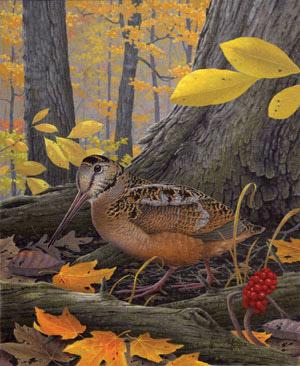Kentucky Afield Outdoors: Woodcock offer an overlooked upland bird hunting opportunity
Published 12:00 am Monday, October 11, 2010

- Kentucky Fish and Wildlife artist Rick Hill's paining of a woodcock called "Timberdoodle."
The courtship flight of the American woodcock is a harbinger of spring, but when the weather warms up and their young are fledged, the squatty little birds with long, flexible bills fly off to the Great Lakes states for the summer.
Back here, upland bird hunters are working their dogs and shooting clay targets with their shotguns in anticipation of the return of the woodcock. Kentucky’s 45-day fall season opens Oct. 16 and closes Nov. 29.
“Woodcock are absent from Kentucky during the hot and dry summer months,” said Rocky Pritchert, migratory bird program coordinator for the Kentucky Department of Fish and Wildlife Resources. “They return for the fall, but when the ground begins to freeze up, they migrate southward to Louisiana and other Gulf Coast states for the winter.”
Kentucky’s statewide woodcock season is sandwiched between these seasonal migrations. The daily bag limit is three birds.
And what’s the reason for all those flights, back and forth, north and south, with twice-a-year stopovers in Kentucky? It’s the pursuit of their preferred food and nesting cover.
“Woodcock have very specific habitat requirements,” said Pritchert. “They need moist ground to probe for earthworms, and thick overhead cover for protection, because they’re a ground nesting bird.”
The American Woodcock (Scolopax minor) spends most of its time on the ground. Woodcock prefer brushy cover and second-growth forests, where the bird’s brown, black and gray plumage provides excellent camouflage.
Forest maturation is one of the reasons woodcock populations in the central U.S. have been declining in the past 20 years. “There’s no indication that hunting and harvest is a contributing factor,” said Pritchert.
There’s so much to like about these incredible little birds. The woodcock has a funky gait that’s so endearing. You’ll be hooked the first time you see one rock its body back and forth without moving its head as it slowly walks. Biologists say it has something to do with detecting earthworms. It could be that the woodcock’s just a born performer.
In the spring, males put on an elaborate display at so-called “singing grounds” to attract females.
After they arrive back in Kentucky, as winter begins to lose its grip, the urge to procreate is so strong the males put on a show late each afternoon. First they give the “peent” call repeatedly, then literally blast off, flying upward in a wide spiral. As the male gets higher, his wings start to twitter. At about 250 feet off the ground, the male woodcock starts chirping, then descends rapidly in a dramatic zig-zag dive, pulling up for a graceful, quiet landing, sure to impress any female.
This “peent” call and display “twitter” can be heard statewide on almost any warm evening from mid-February to early April.
This past spring was the final year of a cooperative research project, studying the stopover and nesting ecology of this popular game bird.
Kentucky Fish and Wildlife biologists and students from Eastern Kentucky University spent evenings locating, capturing and banding woodcock. They attached tiny radio transmitters to females that allowed them to be tracked to nesting sites. The final report is currently being written.
For years, woodcock trends have been monitored by spring call counts, which Pritchert said provide the most reliable information on population size.
“We don’t have an active banding program,” he said. “But we have been trying to band at least 100 woodcock each spring.”
Banding will enable biologists to learn more about the annual migrations of the woodcock. They nest in Kentucky in the spring, return each fall between trips to the Great Lakes in the summer and Gulf Coast in the winter.
Art Lander Jr. has been writing about the outdoors since the 1970s. He is an information specialist with the Kentucky Department of Fish and Wildlife Resources.
The Kentucky Department of Fish and Wildlife Resources manages, regulates, enforces and promotes responsible use of all fish and wildlife species, their habitats, public wildlife areas and waterways for the benefit of those resources and for public enjoyment. Kentucky Fish and Wildlife is an agency of the Tourism, Arts and Heritage Cabinet. For more information on the department, visit our web site at fw.ky.gov.






